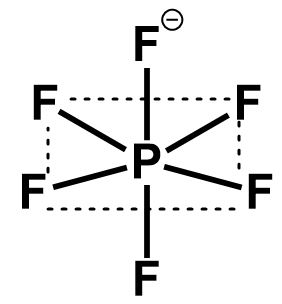
What is the geometry and hybridization of
Answer
401.7k+ views
Hint: Phosphorus is the central atom in the compound
Complete answer:
The ground state electronic configuration of the central phosphorus atom in
The negative charge goes on the fluorine atom as it is more electronegative than phosphorus. Each fluorine atom shares one electron and pairs with the unpaired electron present in the atomic orbitals of phosphorus. The fluoride ion contains eight electrons and simply donates a pair of electrons in the vacant d-orbital of the phosphorus atom. As a result, six atomic orbitals of phosphorus are involved in the formation of
The six atomic orbitals undergo mixing to give six equivalent hybrid orbitals with better overlap, lesser energy and more directional character. These six hybrid orbitals arrange themselves in such a manner to create six equivalent positions for all fluorine atoms. The hybrid orbitals are therefore equal in length and mutually perpendicular to each other. Such a geometry is called an octahedral geometry.

Note:
The structure of
Complete answer:
The ground state electronic configuration of the central phosphorus atom in
The negative charge goes on the fluorine atom as it is more electronegative than phosphorus. Each fluorine atom shares one electron and pairs with the unpaired electron present in the atomic orbitals of phosphorus. The fluoride ion contains eight electrons and simply donates a pair of electrons in the vacant d-orbital of the phosphorus atom. As a result, six atomic orbitals of phosphorus are involved in the formation of
The six atomic orbitals undergo mixing to give six equivalent hybrid orbitals with better overlap, lesser energy and more directional character. These six hybrid orbitals arrange themselves in such a manner to create six equivalent positions for all fluorine atoms. The hybrid orbitals are therefore equal in length and mutually perpendicular to each other. Such a geometry is called an octahedral geometry.

Note:
The structure of
Recently Updated Pages
Master Class 9 General Knowledge: Engaging Questions & Answers for Success

Master Class 9 English: Engaging Questions & Answers for Success

Master Class 9 Science: Engaging Questions & Answers for Success

Master Class 9 Social Science: Engaging Questions & Answers for Success

Master Class 9 Maths: Engaging Questions & Answers for Success

Class 9 Question and Answer - Your Ultimate Solutions Guide

Trending doubts
State and prove Bernoullis theorem class 11 physics CBSE

What are Quantum numbers Explain the quantum number class 11 chemistry CBSE

Who built the Grand Trunk Road AChandragupta Maurya class 11 social science CBSE

1 ton equals to A 100 kg B 1000 kg C 10 kg D 10000 class 11 physics CBSE

State the laws of reflection of light

One Metric ton is equal to kg A 10000 B 1000 C 100 class 11 physics CBSE




